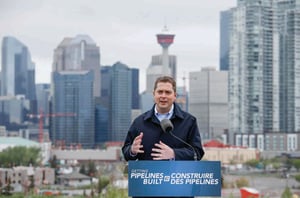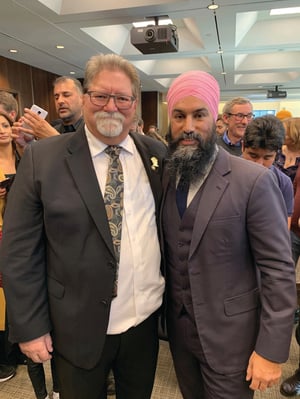All 4 Parties prep for next federal election
Insulators International Staff — Wed, Jul 10, 2019 @ 16:07 PM
Summer is here, and in Canada, the political scene is truly heating up with only a couple months left before the next federal election on Oct. 21. Members of Parliament and candidates from all parties are pounding the pavement, knocking on doors and pitching themselves and their party’s policy agenda to Canadians.
We thought this would provide an opportune time to provide a political lay of the land. Where do each of the parties stand in the eyes of Canadians? What do they need to do to position themselves with voters? What policies are they likely to use to appeal to voters? What will the ballot question be?
For those less familiar with Canadian politics, we have a multi-party, parliamentary system – meaning our Executive branch (Cabinet, led by our Prime Minister) is part of our legislative branch (Parliament or Congress in the U.S.). This means the Prime Minister, and his cabinet ministers, must win their own local seats.
We are going to go through each of the four main parties, starting with the governing Liberal Party, led by Prime Minister Justin Trudeau.
Liberal Party
For several months, the Liberals have been trailing the Conservatives in public opinion polls. The fallout from the SNC-Lavalin scandal of alleged political interference in a corporate criminal proceeding was compounded when further allegations of interference in another court case involving the former head of the Canadian Navy Vice-Admiral Norman.
 Both issues have contributed to the Liberals’ decrease in popularity across the country. While the Liberals have worked to strengthen social and economic policies, such as the Canada Child Benefit Program and Pension Plan, the reality is that they have done a mediocre job at communicating it to Canadians.
Both issues have contributed to the Liberals’ decrease in popularity across the country. While the Liberals have worked to strengthen social and economic policies, such as the Canada Child Benefit Program and Pension Plan, the reality is that they have done a mediocre job at communicating it to Canadians.
The positive narrative of their successful 2015 campaign is no longer resonating with the electorate and Liberal MPs are starting to get nervous as they near the official campaign period at the end of the summer.
The re-election campaign for any governing party is always tough, as voters usually do not have the same enthusiasm that they displayed during the prior election. Moving forward, the Liberal campaign is rolling out a strategy to improve communication, especially the key achievements made by this government over the past four years.
In the next few weeks, we will see the party brand its leader, Prime Minister Trudeau, as a man of action, willing to stand up to President Trump and fighting for Canadian interests. They will back this up by pointing to the success removing President Trump’s tariffs on steel and having brokered a good deal for trade with the new United States-Mexico-Canada Agreement (USMCA).
The party will also want to show a contrast with the Conservatives and depict their leader, Andrew Scheer, as a federal version of the unpopular Conservative Premier of Ontario Doug Ford – someone who will cut important services and programs to all Canadians. Make no mistake, the Achilles heal for the Liberals is the controversial federal carbon tax introduced earlier this year.
Several provincial premiers have vowed to fight this tax and actively campaign against Trudeau in the upcoming election. To counter this tactic, the Liberals will need to point to recent extreme weather events throughout the country to validate the climate change policies.
It will also be important for them to remind Canadians the government has refunded their carbon tax contribution this year through a tax credit, which provided financial relief for families. Although party platforms have not been fully announced, we can be sure the Liberal platform will double down on an approach that, like 2015, focuses on the middle class.
With the cost of a carbon tax still top of mind, it is likely the ballot box question heading into the election will be around affordability, so the Liberals will need to position themselves as the party that will make life easier for Canadians.
If their pre-election budget is any indication of what we should be watching, it will be affordable housing, more jobs, retirement security for seniors and a pharmacare program to make prescription drugs affordable.
In Budget 2019, the Liberals also announced a Canada Training Benefit and a new Apprenticeship Strategy, so we are likely to see policies that will benefit the skilled trades – a key constituency for their progressive voter coalition.
Since 2015, Prime Minister Justin Trudeau and the Liberal government have introduced several insulator-friendly policies, including pre-apprenticeship programs; apprenticeship incentive grants for women; Union Training Innovation Program; Greening Government Operations; Low Carbon Economy Leadership Fund; Green Municipal Fund (supported by the Federation of Canadian Municipalities) and Community Benefits for Infrastructure Funding (Bill C-344).
In addition, and perhaps the biggest win of them all, was the federal asbestos ban, which went into effect in December 2018. The natural next step in the government’s national asbestos strategy should be the development of a National Mesothelioma Patient Registry.
This was reiterated to the Prime Minister when he attended the 2019 CBTU Legislative Conference, and will be at the top of the list, should the Liberal government assume power again on Oct. 21. Following this fall’s federal election would be an opportune time to host a lobby day on Parliament Hill.
This would give Insulators the opportunity to build relationships with new Members of Parliament of all parties early after the election, and to re-engage with MPs whom Insulators already have established relationships. It is an opportunity to discuss the importance of the above mentioned policies, advocate for energy efficiency policies and further discuss the National Mesothelioma Patient Registry and other pressing issues that affect their work.
Conservative Party
After a year and a half of stagnant polling numbers, Canada’s Conservatives have managed to grow their popular support, largely as a result of Liberal missteps on ethics and accountability issues in the early part of 2019. Most public opinion polls have the Conservatives with at least a three-point advantage over the governing Liberals, a margin that widens considerably when polling motivated voters.
Based on the numbers today, the Conservatives would have a shot at forming either a minority government, or even a majority, in the fall. The bump in support has emboldened many federal Conservatives, but has also drawn more attention to their leader, Scheer, and what his policies may be should he form the government after October.
 For their part, the Conservatives are attempting to draw contrast between Scheer and Prime Minister Trudeau on issues like ethics and accountability, but also fiscal management and foreign relations. Despite two years leading the Party, many Canadians still do not have an opinion on Andrew Scheer as a leader, and the Party is now attempting to fill that void in knowledge with concrete policy ideas that differentiate the Blue Team from competitors.
For their part, the Conservatives are attempting to draw contrast between Scheer and Prime Minister Trudeau on issues like ethics and accountability, but also fiscal management and foreign relations. Despite two years leading the Party, many Canadians still do not have an opinion on Andrew Scheer as a leader, and the Party is now attempting to fill that void in knowledge with concrete policy ideas that differentiate the Blue Team from competitors.
Some of the key policies Scheer has highlighted to date include:
- Developing a cross-Canada “energy corridor,” with a specific focus on getting pipeline projects reviewed and approved.
- Cancelling the federal carbon tax.
- Removing the GST off home heating bills, as well as removing tax from parental benefits.
- Removing Canada’s participation in China’s Asian Infrastructure Investment Bank, and ceasing Canada’s own Infrastructure Bank.
- Returning the budget to balance (though not on the two-year timeframe initially proposed).
- Encouraging new home construction as a means of addressing the country’s housing shortage.
The Conservatives approach to economic and infrastructure issues can perhaps be best summarized as less regulation, more development.
This pro-development approach, coupled with vocal support for skilled trades training should be viewed positively by Canada’s Heat and Frost Insulators, particularly as it relates to energy development. The intention of federal conservatives (and now, many provincial Premiers) is to get the ball rolling on new projects, which could mean more
work for the trade.
That said, the Conservatives have a decidedly different philosophy around environmental initiatives and incentives – many of which have benefitted Insulators in the past. Existing commitments around green buildings and infrastructure are less certain with the federal Conservatives – particularly as the cancellation of a carbon tax is likely to result in less funding available to resource these programs.
That said, Tories put an emphasis on finding financial efficiencies, and supporting energy-efficient infrastructure, which aligns with the message Insulators have been sharing in Canada for some time. In general, Conservatives also responded favourably to our advocacy around energy efficiency and Insulators will be well-positioned to engage a potential new Conservative government, should Scheer convince Canadians he’s the right Leader for the Prime Minister’s job.
New Democratic Party
Canada’s New Democrats are generally viewed to be the furthest to the left on the Canadian political spectrum. They are a social democratic party formed out of a union between a former socialist party and the Canadian labour movement.
 Thus, they are very supportive of labour unions, worker’s rights and progressive causes like income inequality. The closest comparison in U.S. politics would be Bernie Sanders – a self-identified democratic socialist. The NDP has the newest leader compared to the other main parties, Jagmeet Singh, who also happens to be the first visible minority leader of a major federal party in Canada.
Thus, they are very supportive of labour unions, worker’s rights and progressive causes like income inequality. The closest comparison in U.S. politics would be Bernie Sanders – a self-identified democratic socialist. The NDP has the newest leader compared to the other main parties, Jagmeet Singh, who also happens to be the first visible minority leader of a major federal party in Canada.
Singh has struggled at the helm of the NDP since taking over the leadership in 2017.
The NDP, which started the 2015 campaign in a dead heat with the then governing Conservatives, has found itself stuck in third place with around 15-18 percent support in public opinion. Singh is still not a well-known leader among Canadians and he has endured a tumultuous time as leader with many in his own party and even caucus, questioning his leadership.
The weakness of the governing Liberals, coupled with the frustration within the progressive coalition of voters who elected them, might favor Singh, provided he and the NDP can successfully advance the narrative that the Liberals are not on the side of everyday, working Canadians.
Watch for the NDP to use recent Liberal scandals to portray Trudeau and his party as on the side of wealthy, corporate insiders and not looking out for the people who elected them. In terms of policy, the NDP went ahead and launched their platform in June – a strategic decision to reinforce their progressive policy credentials early in an effort to win back some of the progressives who left the fold to support the Liberals in 2015.
The strategy is likely based on the assumption this will not be an election fought over policy, but rather leadership and broad vision. The NDP’s policy platform is built on a number of key pillars:
- The most ambitious climate change agenda in Canadian history – a plan to invest $15 billion over the first mandate to meet and exceed Canada’s Paris GHG targets.
- A major affordable housing initiative to build 500,000 affordable housing units over 10 years.
- A universal, single-payer pharmacare program to provide prescription drug coverage for all Canadians via a program similar to Canada’s public health care system.
Singh has not enjoyed the best relationship with the skilled trades, thanks to lacklustre performances in his two addresses to the Canada Building Trades Union delegates during their last two Legislative Conferences.
Members have not been impressed by him or his engagement with the CBTU, so he will have his work cut out for him in order to win over Canada’s skilled workers.
The NDP will point to their bold policy agenda, which includes major infrastructure spending initiatives for transit, building retrofits – residential/housing, commercial and industrial. Singh boasts these investments will create 300,000 jobs in the first mandate of NDP government.
In order for us to find out if that is true, they will have to win votes back from the Liberals, while staving off the momentum enjoyed by the surging Green Party.
Green Party
The most experienced and longest-serving leader of any of the four main parties is actually Green Party Leader Elizabeth May. She also enjoys the strongest favourability rating among Canadians, according to public opinion polls, and is considered the most trustworthy of the lot – and trust is currency for political leaders.
The Greens do indeed have the wind in their sails, having doubled the size of their Parliamentary Caucus from one – their Leader – to two, thanks to a by-election win in British Columbia earlier this year. They have also had some historic results in provincial elections, including forming the official opposition on Prince Edward Island (Canada’s smallest province) and winning more seats in British Columbia, Ontario and New Brunswick.
The environment has been a hot topic in Canadian politics, with many voters anxious about climate change, frustrated with Trudeau for supporting new pipelines and not doing enough to reduce emissions.
This has opened up a window of opportunity for the Greens but it is not the only reason Canadians are turning to the party. Recent federal political scandals and frustration with all parties is helping the Greens present themselves as a new and perhaps untainted option.
May’s popularity and personal brand built over the many years of her leadership, have helped make the Greens look more and more like a viable option.
With the official election period around the corner, your Canadian advocacy team is primed and ready to ensure, regardless of which party wins in October, Canada’s Heat and Frost Insulators will be at the table, influencing and shaping federal government policy to support our workers and the Canadian economy.